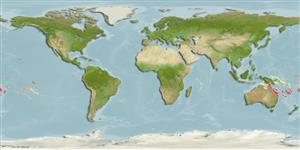Common names from other countries
Environment: milieu / climate zone / depth range / distribution range
Ecologia
marinhas; estuarina associadas(os) a recifes; intervalo de profundidade 2 - 30 m (Ref. 89972). Tropical; 0°N - 30°S
Pacific Ocean: Australia to Pitcairn.
Tamanho / Peso / Idade
Maturity: Lm ? range ? - ? cm
Max length : 20.0 cm TL macho/indeterminado; (Ref. 9710)
Espinhos dorsais (total) : 12 - 13; Raios dorsais moles (total) : 24 - 27; Espinhos anais: 3; Raios anais moles: 20 - 21. Overall color is blackish with broad rim of yellow on dorsal caudal and anal fins. The snout is yellow with white tips. A black bump is on the forehead.
Found in coral rich to algae-covered rocky areas of lagoon and seaward reefs including estuarine areas. Usually paired (Ref. 9710). Omnivorous and feeds on algae, coral, and small benthic invertebrates. Oviparous (Ref. 205). Form pairs during breeding (Ref. 205). Maintaining this species in captivity is difficult.
Life cycle and mating behavior
Maturities | Reprodução | Spawnings | Egg(s) | Fecundities | Larvas
Form pairs during breeding (Ref. 205). Monogamous mating is observed as both obligate and social (Ref. 52884).
Steene, R.C., 1978. Butterfly and angelfishes of the world. A.H. & A.W. Reed Pty Ltd., Australia. vol. 1. 144 p. (Ref. 4859)
Categoria na Lista Vermelha da IUCN (Ref. 130435)
CITES (Ref. 128078)
Not Evaluated
Utilização humana
Pescarias: espécies comerciais; Aquário: Espécies comerciais
Ferramentas
Relatórios especiais
Descarregue XML
Fontes da internet
Estimates based on models
Preferred temperature (Ref.
115969): 23.9 - 28.1, mean 26.4 (based on 448 cells).
Phylogenetic diversity index (Ref.
82804): PD
50 = 0.5000 [Uniqueness, from 0.5 = low to 2.0 = high].
Bayesian length-weight: a=0.02455 (0.01583 - 0.03806), b=3.05 (2.92 - 3.18), in cm Total Length, based on LWR estimates for this species & Genus-body shape (Ref.
93245).
Nível Trófico (Ref.
69278): 3.0 ±0.41 se; based on food items.
Resiliência (Ref.
120179): Elevada, tempo mínimo de duplicação da população menor que 15 meses (Preliminary K or Fecundity.).
Fishing Vulnerability (Ref.
59153): Low vulnerability (10 of 100).
